Applying Bandura's Social Learning Theory in Clinical Settings
VerifiedAdded on 2020/02/24
|11
|2749
|69
Report
AI Summary
This report delves into Bandura's Social Learning Theory, emphasizing its relevance in the clinical environment and its implications for nurse education and practice. The report begins with an executive summary of the challenges faced by teachers and learners, specifically focusing on how Bandura’s social learning theory can facilitate learning in a clinical setting, where nurses learn through observation, imitation, and modeling. The discussion includes a critical analysis of the theory within the clinical environment, highlighting the importance of role models and observational learning. The report further explores how this theory can facilitate the learning of nurses, discussing the key principles of attention, retention, reproduction, and motivation. It examines the application of the theory in the context of the clinical environment, including the role of skilled mentors and the impact of vicarious reinforcement. The report concludes by summarizing the key points and emphasizing the significance of social learning theory in shaping the education and practice of nurses. The report also provides a comprehensive understanding of the theory's principles and their practical application in the healthcare field.
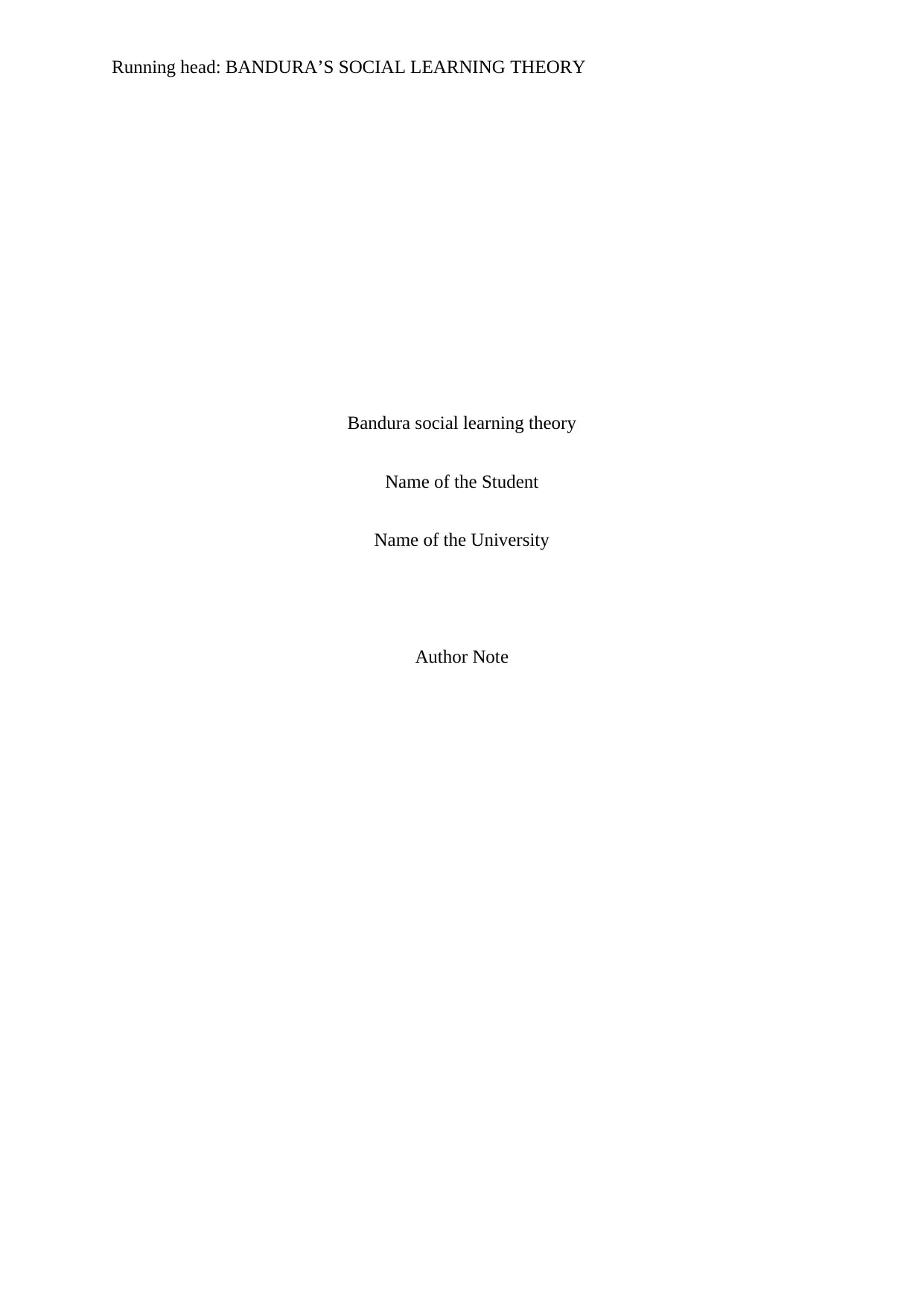
Running head: BANDURA’S SOCIAL LEARNING THEORY
Bandura social learning theory
Name of the Student
Name of the University
Author Note
Bandura social learning theory
Name of the Student
Name of the University
Author Note
Paraphrase This Document
Need a fresh take? Get an instant paraphrase of this document with our AI Paraphraser
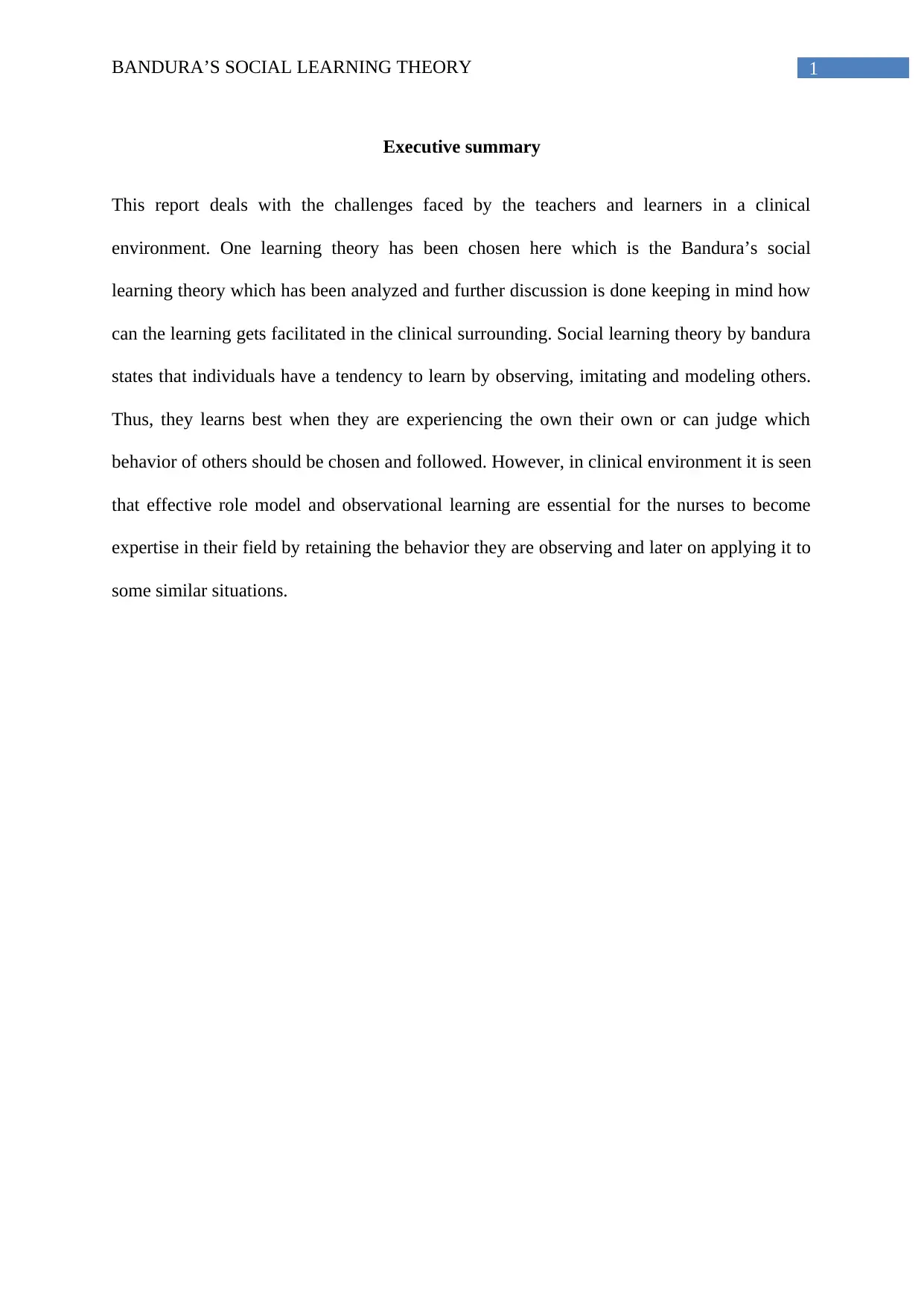
1BANDURA’S SOCIAL LEARNING THEORY
Executive summary
This report deals with the challenges faced by the teachers and learners in a clinical
environment. One learning theory has been chosen here which is the Bandura’s social
learning theory which has been analyzed and further discussion is done keeping in mind how
can the learning gets facilitated in the clinical surrounding. Social learning theory by bandura
states that individuals have a tendency to learn by observing, imitating and modeling others.
Thus, they learns best when they are experiencing the own their own or can judge which
behavior of others should be chosen and followed. However, in clinical environment it is seen
that effective role model and observational learning are essential for the nurses to become
expertise in their field by retaining the behavior they are observing and later on applying it to
some similar situations.
Executive summary
This report deals with the challenges faced by the teachers and learners in a clinical
environment. One learning theory has been chosen here which is the Bandura’s social
learning theory which has been analyzed and further discussion is done keeping in mind how
can the learning gets facilitated in the clinical surrounding. Social learning theory by bandura
states that individuals have a tendency to learn by observing, imitating and modeling others.
Thus, they learns best when they are experiencing the own their own or can judge which
behavior of others should be chosen and followed. However, in clinical environment it is seen
that effective role model and observational learning are essential for the nurses to become
expertise in their field by retaining the behavior they are observing and later on applying it to
some similar situations.
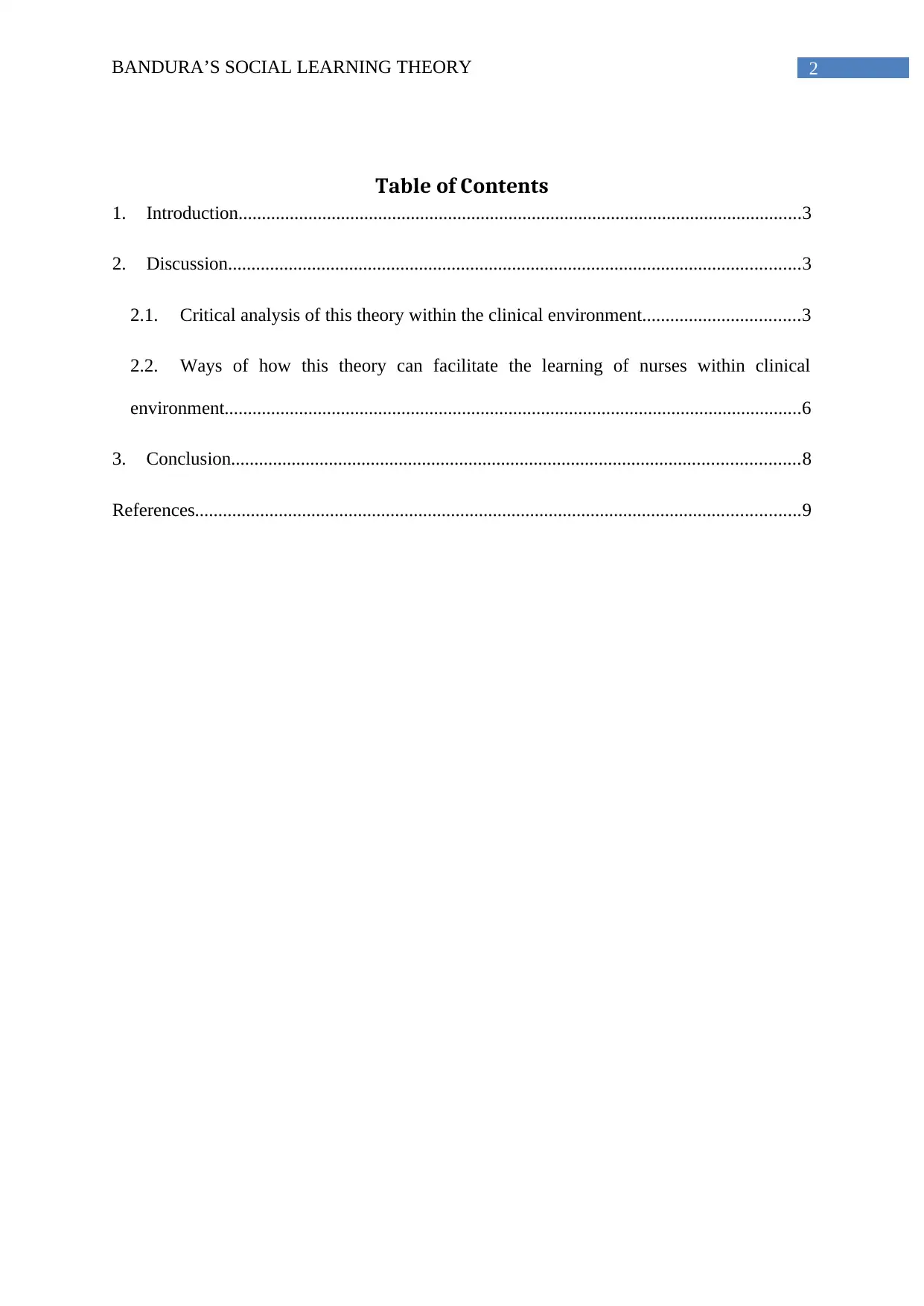
2BANDURA’S SOCIAL LEARNING THEORY
Table of Contents
1. Introduction.........................................................................................................................3
2. Discussion...........................................................................................................................3
2.1. Critical analysis of this theory within the clinical environment..................................3
2.2. Ways of how this theory can facilitate the learning of nurses within clinical
environment............................................................................................................................6
3. Conclusion..........................................................................................................................8
References..................................................................................................................................9
Table of Contents
1. Introduction.........................................................................................................................3
2. Discussion...........................................................................................................................3
2.1. Critical analysis of this theory within the clinical environment..................................3
2.2. Ways of how this theory can facilitate the learning of nurses within clinical
environment............................................................................................................................6
3. Conclusion..........................................................................................................................8
References..................................................................................................................................9
⊘ This is a preview!⊘
Do you want full access?
Subscribe today to unlock all pages.

Trusted by 1+ million students worldwide
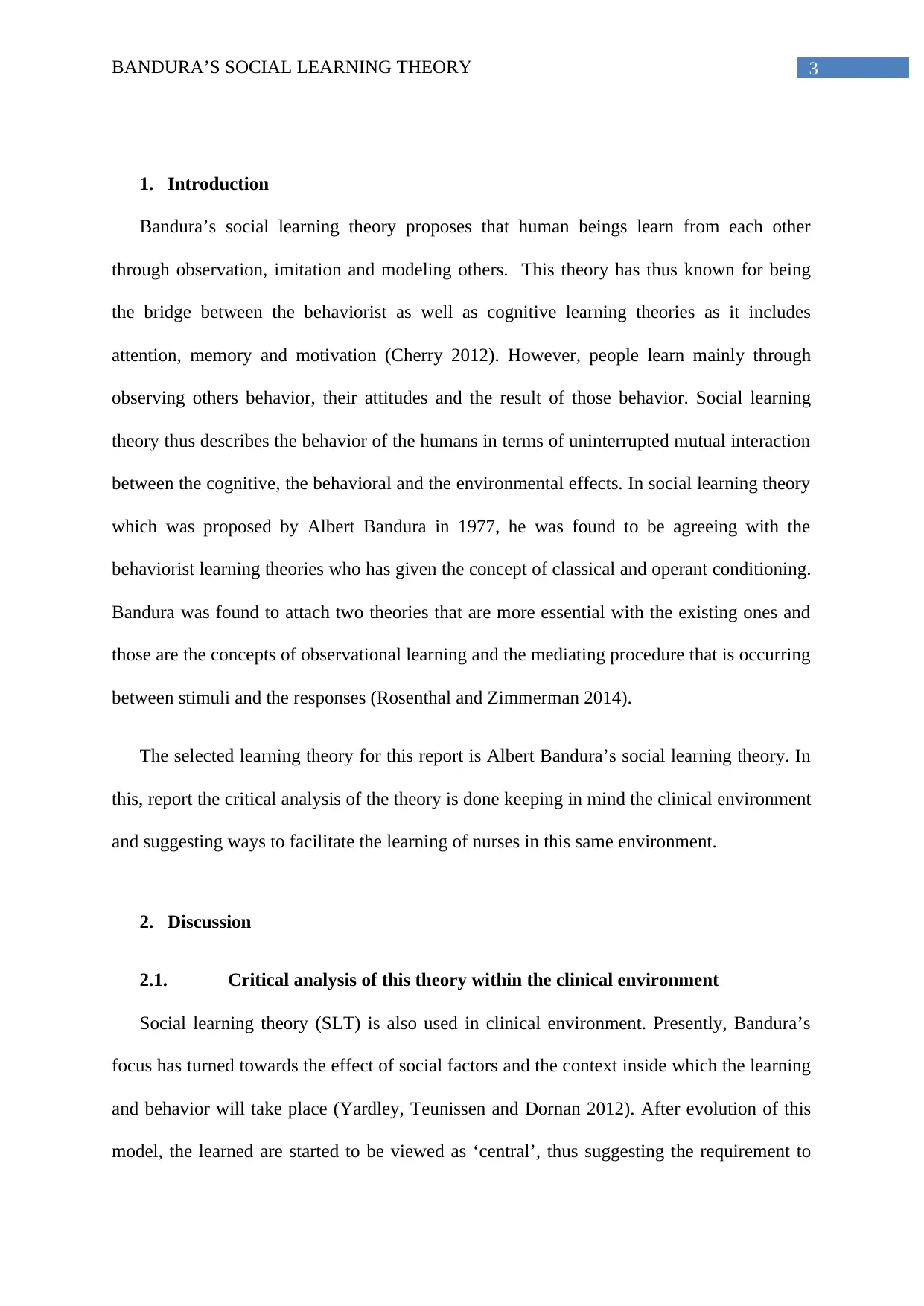
3BANDURA’S SOCIAL LEARNING THEORY
1. Introduction
Bandura’s social learning theory proposes that human beings learn from each other
through observation, imitation and modeling others. This theory has thus known for being
the bridge between the behaviorist as well as cognitive learning theories as it includes
attention, memory and motivation (Cherry 2012). However, people learn mainly through
observing others behavior, their attitudes and the result of those behavior. Social learning
theory thus describes the behavior of the humans in terms of uninterrupted mutual interaction
between the cognitive, the behavioral and the environmental effects. In social learning theory
which was proposed by Albert Bandura in 1977, he was found to be agreeing with the
behaviorist learning theories who has given the concept of classical and operant conditioning.
Bandura was found to attach two theories that are more essential with the existing ones and
those are the concepts of observational learning and the mediating procedure that is occurring
between stimuli and the responses (Rosenthal and Zimmerman 2014).
The selected learning theory for this report is Albert Bandura’s social learning theory. In
this, report the critical analysis of the theory is done keeping in mind the clinical environment
and suggesting ways to facilitate the learning of nurses in this same environment.
2. Discussion
2.1. Critical analysis of this theory within the clinical environment
Social learning theory (SLT) is also used in clinical environment. Presently, Bandura’s
focus has turned towards the effect of social factors and the context inside which the learning
and behavior will take place (Yardley, Teunissen and Dornan 2012). After evolution of this
model, the learned are started to be viewed as ‘central’, thus suggesting the requirement to
1. Introduction
Bandura’s social learning theory proposes that human beings learn from each other
through observation, imitation and modeling others. This theory has thus known for being
the bridge between the behaviorist as well as cognitive learning theories as it includes
attention, memory and motivation (Cherry 2012). However, people learn mainly through
observing others behavior, their attitudes and the result of those behavior. Social learning
theory thus describes the behavior of the humans in terms of uninterrupted mutual interaction
between the cognitive, the behavioral and the environmental effects. In social learning theory
which was proposed by Albert Bandura in 1977, he was found to be agreeing with the
behaviorist learning theories who has given the concept of classical and operant conditioning.
Bandura was found to attach two theories that are more essential with the existing ones and
those are the concepts of observational learning and the mediating procedure that is occurring
between stimuli and the responses (Rosenthal and Zimmerman 2014).
The selected learning theory for this report is Albert Bandura’s social learning theory. In
this, report the critical analysis of the theory is done keeping in mind the clinical environment
and suggesting ways to facilitate the learning of nurses in this same environment.
2. Discussion
2.1. Critical analysis of this theory within the clinical environment
Social learning theory (SLT) is also used in clinical environment. Presently, Bandura’s
focus has turned towards the effect of social factors and the context inside which the learning
and behavior will take place (Yardley, Teunissen and Dornan 2012). After evolution of this
model, the learned are started to be viewed as ‘central’, thus suggesting the requirement to
Paraphrase This Document
Need a fresh take? Get an instant paraphrase of this document with our AI Paraphraser
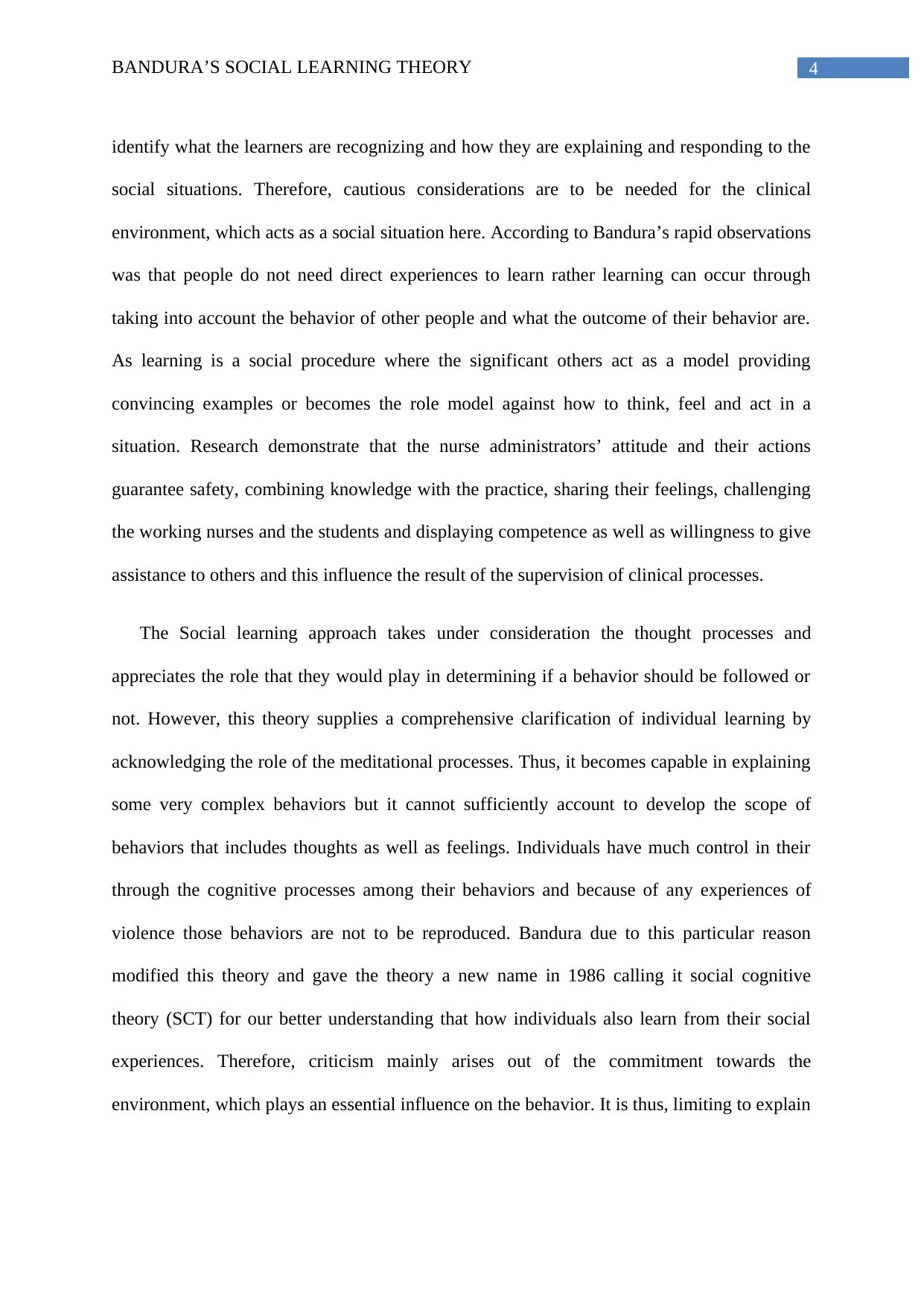
4BANDURA’S SOCIAL LEARNING THEORY
identify what the learners are recognizing and how they are explaining and responding to the
social situations. Therefore, cautious considerations are to be needed for the clinical
environment, which acts as a social situation here. According to Bandura’s rapid observations
was that people do not need direct experiences to learn rather learning can occur through
taking into account the behavior of other people and what the outcome of their behavior are.
As learning is a social procedure where the significant others act as a model providing
convincing examples or becomes the role model against how to think, feel and act in a
situation. Research demonstrate that the nurse administrators’ attitude and their actions
guarantee safety, combining knowledge with the practice, sharing their feelings, challenging
the working nurses and the students and displaying competence as well as willingness to give
assistance to others and this influence the result of the supervision of clinical processes.
The Social learning approach takes under consideration the thought processes and
appreciates the role that they would play in determining if a behavior should be followed or
not. However, this theory supplies a comprehensive clarification of individual learning by
acknowledging the role of the meditational processes. Thus, it becomes capable in explaining
some very complex behaviors but it cannot sufficiently account to develop the scope of
behaviors that includes thoughts as well as feelings. Individuals have much control in their
through the cognitive processes among their behaviors and because of any experiences of
violence those behaviors are not to be reproduced. Bandura due to this particular reason
modified this theory and gave the theory a new name in 1986 calling it social cognitive
theory (SCT) for our better understanding that how individuals also learn from their social
experiences. Therefore, criticism mainly arises out of the commitment towards the
environment, which plays an essential influence on the behavior. It is thus, limiting to explain
identify what the learners are recognizing and how they are explaining and responding to the
social situations. Therefore, cautious considerations are to be needed for the clinical
environment, which acts as a social situation here. According to Bandura’s rapid observations
was that people do not need direct experiences to learn rather learning can occur through
taking into account the behavior of other people and what the outcome of their behavior are.
As learning is a social procedure where the significant others act as a model providing
convincing examples or becomes the role model against how to think, feel and act in a
situation. Research demonstrate that the nurse administrators’ attitude and their actions
guarantee safety, combining knowledge with the practice, sharing their feelings, challenging
the working nurses and the students and displaying competence as well as willingness to give
assistance to others and this influence the result of the supervision of clinical processes.
The Social learning approach takes under consideration the thought processes and
appreciates the role that they would play in determining if a behavior should be followed or
not. However, this theory supplies a comprehensive clarification of individual learning by
acknowledging the role of the meditational processes. Thus, it becomes capable in explaining
some very complex behaviors but it cannot sufficiently account to develop the scope of
behaviors that includes thoughts as well as feelings. Individuals have much control in their
through the cognitive processes among their behaviors and because of any experiences of
violence those behaviors are not to be reproduced. Bandura due to this particular reason
modified this theory and gave the theory a new name in 1986 calling it social cognitive
theory (SCT) for our better understanding that how individuals also learn from their social
experiences. Therefore, criticism mainly arises out of the commitment towards the
environment, which plays an essential influence on the behavior. It is thus, limiting to explain
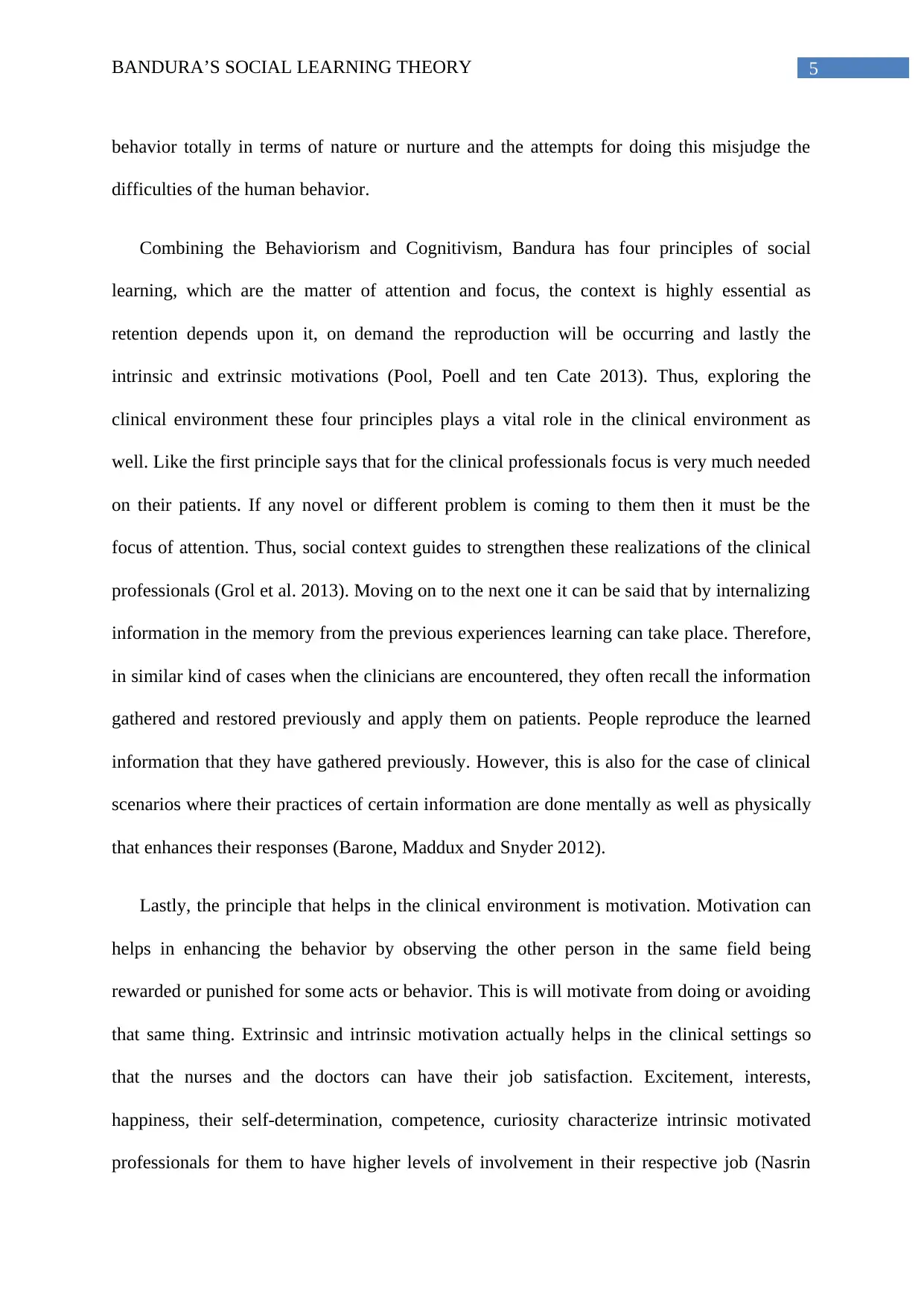
5BANDURA’S SOCIAL LEARNING THEORY
behavior totally in terms of nature or nurture and the attempts for doing this misjudge the
difficulties of the human behavior.
Combining the Behaviorism and Cognitivism, Bandura has four principles of social
learning, which are the matter of attention and focus, the context is highly essential as
retention depends upon it, on demand the reproduction will be occurring and lastly the
intrinsic and extrinsic motivations (Pool, Poell and ten Cate 2013). Thus, exploring the
clinical environment these four principles plays a vital role in the clinical environment as
well. Like the first principle says that for the clinical professionals focus is very much needed
on their patients. If any novel or different problem is coming to them then it must be the
focus of attention. Thus, social context guides to strengthen these realizations of the clinical
professionals (Grol et al. 2013). Moving on to the next one it can be said that by internalizing
information in the memory from the previous experiences learning can take place. Therefore,
in similar kind of cases when the clinicians are encountered, they often recall the information
gathered and restored previously and apply them on patients. People reproduce the learned
information that they have gathered previously. However, this is also for the case of clinical
scenarios where their practices of certain information are done mentally as well as physically
that enhances their responses (Barone, Maddux and Snyder 2012).
Lastly, the principle that helps in the clinical environment is motivation. Motivation can
helps in enhancing the behavior by observing the other person in the same field being
rewarded or punished for some acts or behavior. This is will motivate from doing or avoiding
that same thing. Extrinsic and intrinsic motivation actually helps in the clinical settings so
that the nurses and the doctors can have their job satisfaction. Excitement, interests,
happiness, their self-determination, competence, curiosity characterize intrinsic motivated
professionals for them to have higher levels of involvement in their respective job (Nasrin
behavior totally in terms of nature or nurture and the attempts for doing this misjudge the
difficulties of the human behavior.
Combining the Behaviorism and Cognitivism, Bandura has four principles of social
learning, which are the matter of attention and focus, the context is highly essential as
retention depends upon it, on demand the reproduction will be occurring and lastly the
intrinsic and extrinsic motivations (Pool, Poell and ten Cate 2013). Thus, exploring the
clinical environment these four principles plays a vital role in the clinical environment as
well. Like the first principle says that for the clinical professionals focus is very much needed
on their patients. If any novel or different problem is coming to them then it must be the
focus of attention. Thus, social context guides to strengthen these realizations of the clinical
professionals (Grol et al. 2013). Moving on to the next one it can be said that by internalizing
information in the memory from the previous experiences learning can take place. Therefore,
in similar kind of cases when the clinicians are encountered, they often recall the information
gathered and restored previously and apply them on patients. People reproduce the learned
information that they have gathered previously. However, this is also for the case of clinical
scenarios where their practices of certain information are done mentally as well as physically
that enhances their responses (Barone, Maddux and Snyder 2012).
Lastly, the principle that helps in the clinical environment is motivation. Motivation can
helps in enhancing the behavior by observing the other person in the same field being
rewarded or punished for some acts or behavior. This is will motivate from doing or avoiding
that same thing. Extrinsic and intrinsic motivation actually helps in the clinical settings so
that the nurses and the doctors can have their job satisfaction. Excitement, interests,
happiness, their self-determination, competence, curiosity characterize intrinsic motivated
professionals for them to have higher levels of involvement in their respective job (Nasrin
⊘ This is a preview!⊘
Do you want full access?
Subscribe today to unlock all pages.

Trusted by 1+ million students worldwide
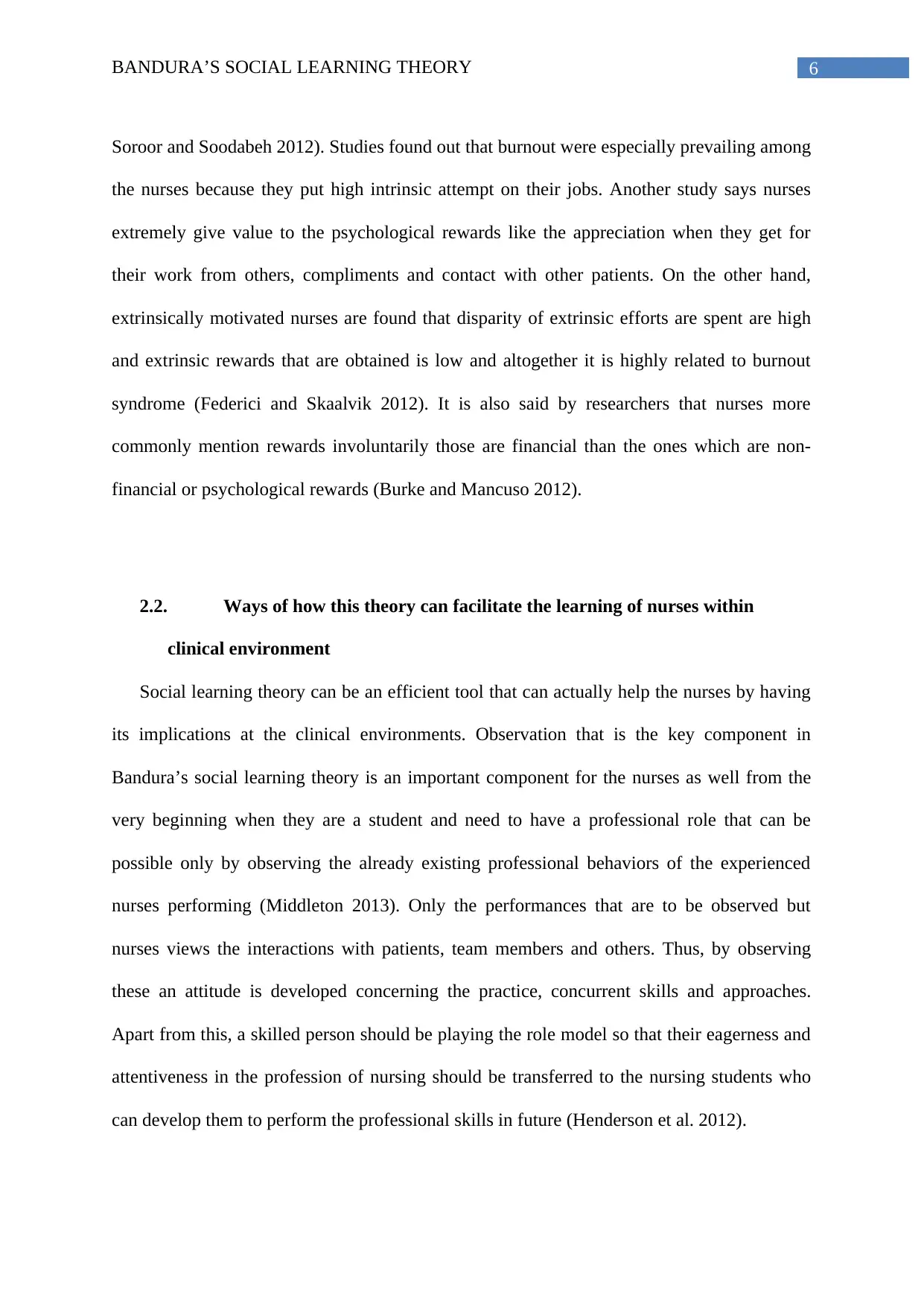
6BANDURA’S SOCIAL LEARNING THEORY
Soroor and Soodabeh 2012). Studies found out that burnout were especially prevailing among
the nurses because they put high intrinsic attempt on their jobs. Another study says nurses
extremely give value to the psychological rewards like the appreciation when they get for
their work from others, compliments and contact with other patients. On the other hand,
extrinsically motivated nurses are found that disparity of extrinsic efforts are spent are high
and extrinsic rewards that are obtained is low and altogether it is highly related to burnout
syndrome (Federici and Skaalvik 2012). It is also said by researchers that nurses more
commonly mention rewards involuntarily those are financial than the ones which are non-
financial or psychological rewards (Burke and Mancuso 2012).
2.2. Ways of how this theory can facilitate the learning of nurses within
clinical environment
Social learning theory can be an efficient tool that can actually help the nurses by having
its implications at the clinical environments. Observation that is the key component in
Bandura’s social learning theory is an important component for the nurses as well from the
very beginning when they are a student and need to have a professional role that can be
possible only by observing the already existing professional behaviors of the experienced
nurses performing (Middleton 2013). Only the performances that are to be observed but
nurses views the interactions with patients, team members and others. Thus, by observing
these an attitude is developed concerning the practice, concurrent skills and approaches.
Apart from this, a skilled person should be playing the role model so that their eagerness and
attentiveness in the profession of nursing should be transferred to the nursing students who
can develop them to perform the professional skills in future (Henderson et al. 2012).
Soroor and Soodabeh 2012). Studies found out that burnout were especially prevailing among
the nurses because they put high intrinsic attempt on their jobs. Another study says nurses
extremely give value to the psychological rewards like the appreciation when they get for
their work from others, compliments and contact with other patients. On the other hand,
extrinsically motivated nurses are found that disparity of extrinsic efforts are spent are high
and extrinsic rewards that are obtained is low and altogether it is highly related to burnout
syndrome (Federici and Skaalvik 2012). It is also said by researchers that nurses more
commonly mention rewards involuntarily those are financial than the ones which are non-
financial or psychological rewards (Burke and Mancuso 2012).
2.2. Ways of how this theory can facilitate the learning of nurses within
clinical environment
Social learning theory can be an efficient tool that can actually help the nurses by having
its implications at the clinical environments. Observation that is the key component in
Bandura’s social learning theory is an important component for the nurses as well from the
very beginning when they are a student and need to have a professional role that can be
possible only by observing the already existing professional behaviors of the experienced
nurses performing (Middleton 2013). Only the performances that are to be observed but
nurses views the interactions with patients, team members and others. Thus, by observing
these an attitude is developed concerning the practice, concurrent skills and approaches.
Apart from this, a skilled person should be playing the role model so that their eagerness and
attentiveness in the profession of nursing should be transferred to the nursing students who
can develop them to perform the professional skills in future (Henderson et al. 2012).
Paraphrase This Document
Need a fresh take? Get an instant paraphrase of this document with our AI Paraphraser
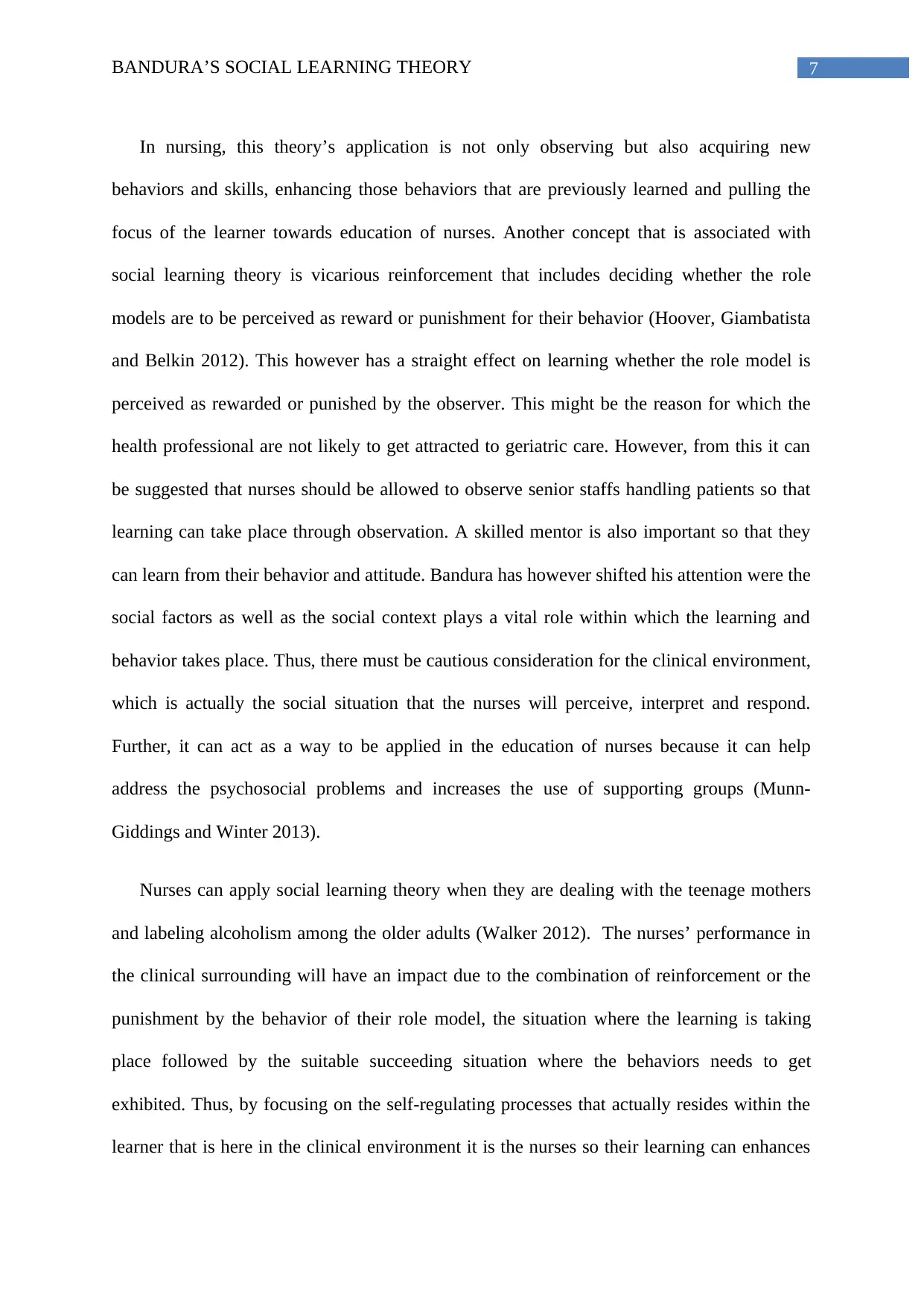
7BANDURA’S SOCIAL LEARNING THEORY
In nursing, this theory’s application is not only observing but also acquiring new
behaviors and skills, enhancing those behaviors that are previously learned and pulling the
focus of the learner towards education of nurses. Another concept that is associated with
social learning theory is vicarious reinforcement that includes deciding whether the role
models are to be perceived as reward or punishment for their behavior (Hoover, Giambatista
and Belkin 2012). This however has a straight effect on learning whether the role model is
perceived as rewarded or punished by the observer. This might be the reason for which the
health professional are not likely to get attracted to geriatric care. However, from this it can
be suggested that nurses should be allowed to observe senior staffs handling patients so that
learning can take place through observation. A skilled mentor is also important so that they
can learn from their behavior and attitude. Bandura has however shifted his attention were the
social factors as well as the social context plays a vital role within which the learning and
behavior takes place. Thus, there must be cautious consideration for the clinical environment,
which is actually the social situation that the nurses will perceive, interpret and respond.
Further, it can act as a way to be applied in the education of nurses because it can help
address the psychosocial problems and increases the use of supporting groups (Munn-
Giddings and Winter 2013).
Nurses can apply social learning theory when they are dealing with the teenage mothers
and labeling alcoholism among the older adults (Walker 2012). The nurses’ performance in
the clinical surrounding will have an impact due to the combination of reinforcement or the
punishment by the behavior of their role model, the situation where the learning is taking
place followed by the suitable succeeding situation where the behaviors needs to get
exhibited. Thus, by focusing on the self-regulating processes that actually resides within the
learner that is here in the clinical environment it is the nurses so their learning can enhances
In nursing, this theory’s application is not only observing but also acquiring new
behaviors and skills, enhancing those behaviors that are previously learned and pulling the
focus of the learner towards education of nurses. Another concept that is associated with
social learning theory is vicarious reinforcement that includes deciding whether the role
models are to be perceived as reward or punishment for their behavior (Hoover, Giambatista
and Belkin 2012). This however has a straight effect on learning whether the role model is
perceived as rewarded or punished by the observer. This might be the reason for which the
health professional are not likely to get attracted to geriatric care. However, from this it can
be suggested that nurses should be allowed to observe senior staffs handling patients so that
learning can take place through observation. A skilled mentor is also important so that they
can learn from their behavior and attitude. Bandura has however shifted his attention were the
social factors as well as the social context plays a vital role within which the learning and
behavior takes place. Thus, there must be cautious consideration for the clinical environment,
which is actually the social situation that the nurses will perceive, interpret and respond.
Further, it can act as a way to be applied in the education of nurses because it can help
address the psychosocial problems and increases the use of supporting groups (Munn-
Giddings and Winter 2013).
Nurses can apply social learning theory when they are dealing with the teenage mothers
and labeling alcoholism among the older adults (Walker 2012). The nurses’ performance in
the clinical surrounding will have an impact due to the combination of reinforcement or the
punishment by the behavior of their role model, the situation where the learning is taking
place followed by the suitable succeeding situation where the behaviors needs to get
exhibited. Thus, by focusing on the self-regulating processes that actually resides within the
learner that is here in the clinical environment it is the nurses so their learning can enhances
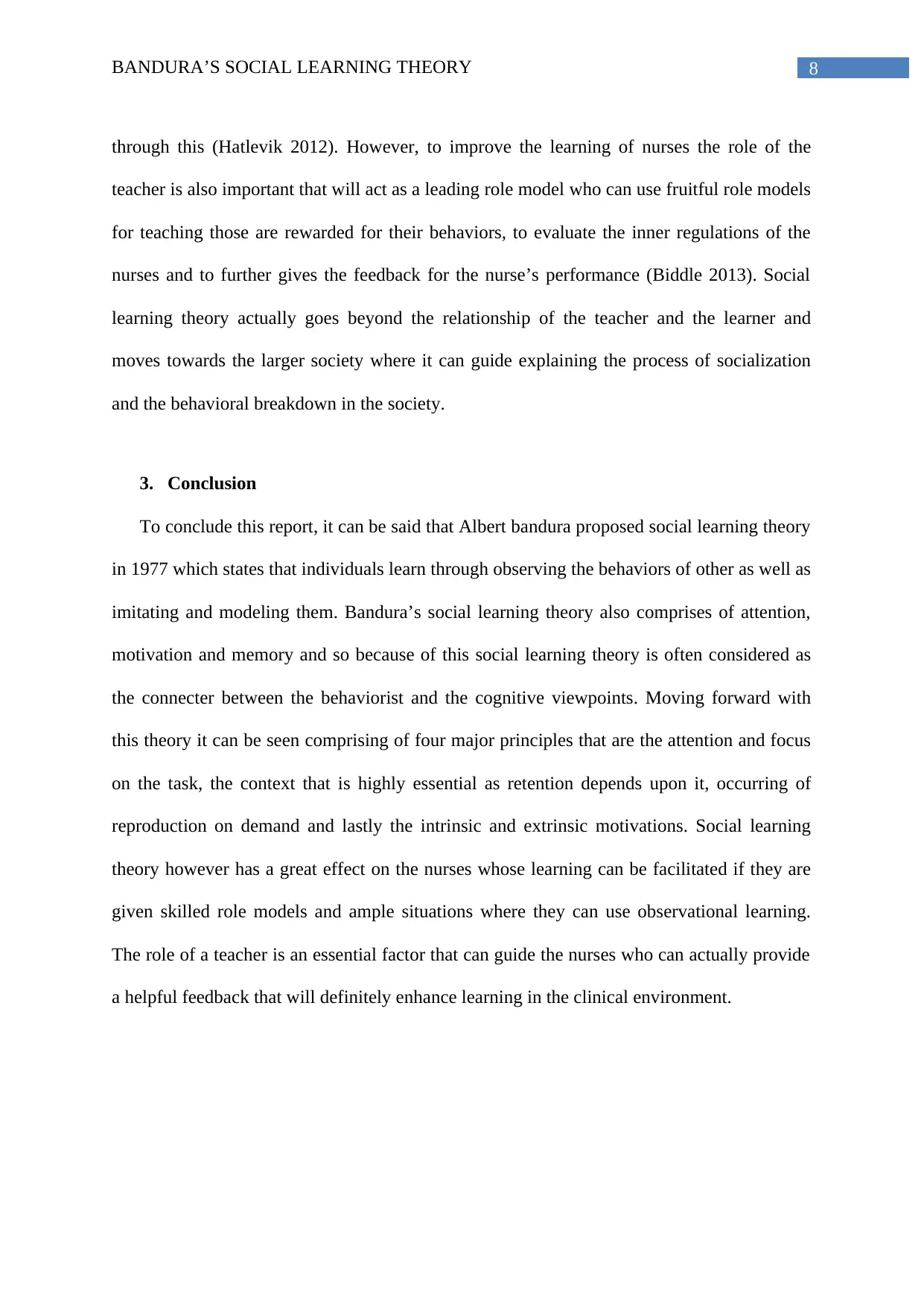
8BANDURA’S SOCIAL LEARNING THEORY
through this (Hatlevik 2012). However, to improve the learning of nurses the role of the
teacher is also important that will act as a leading role model who can use fruitful role models
for teaching those are rewarded for their behaviors, to evaluate the inner regulations of the
nurses and to further gives the feedback for the nurse’s performance (Biddle 2013). Social
learning theory actually goes beyond the relationship of the teacher and the learner and
moves towards the larger society where it can guide explaining the process of socialization
and the behavioral breakdown in the society.
3. Conclusion
To conclude this report, it can be said that Albert bandura proposed social learning theory
in 1977 which states that individuals learn through observing the behaviors of other as well as
imitating and modeling them. Bandura’s social learning theory also comprises of attention,
motivation and memory and so because of this social learning theory is often considered as
the connecter between the behaviorist and the cognitive viewpoints. Moving forward with
this theory it can be seen comprising of four major principles that are the attention and focus
on the task, the context that is highly essential as retention depends upon it, occurring of
reproduction on demand and lastly the intrinsic and extrinsic motivations. Social learning
theory however has a great effect on the nurses whose learning can be facilitated if they are
given skilled role models and ample situations where they can use observational learning.
The role of a teacher is an essential factor that can guide the nurses who can actually provide
a helpful feedback that will definitely enhance learning in the clinical environment.
through this (Hatlevik 2012). However, to improve the learning of nurses the role of the
teacher is also important that will act as a leading role model who can use fruitful role models
for teaching those are rewarded for their behaviors, to evaluate the inner regulations of the
nurses and to further gives the feedback for the nurse’s performance (Biddle 2013). Social
learning theory actually goes beyond the relationship of the teacher and the learner and
moves towards the larger society where it can guide explaining the process of socialization
and the behavioral breakdown in the society.
3. Conclusion
To conclude this report, it can be said that Albert bandura proposed social learning theory
in 1977 which states that individuals learn through observing the behaviors of other as well as
imitating and modeling them. Bandura’s social learning theory also comprises of attention,
motivation and memory and so because of this social learning theory is often considered as
the connecter between the behaviorist and the cognitive viewpoints. Moving forward with
this theory it can be seen comprising of four major principles that are the attention and focus
on the task, the context that is highly essential as retention depends upon it, occurring of
reproduction on demand and lastly the intrinsic and extrinsic motivations. Social learning
theory however has a great effect on the nurses whose learning can be facilitated if they are
given skilled role models and ample situations where they can use observational learning.
The role of a teacher is an essential factor that can guide the nurses who can actually provide
a helpful feedback that will definitely enhance learning in the clinical environment.
⊘ This is a preview!⊘
Do you want full access?
Subscribe today to unlock all pages.

Trusted by 1+ million students worldwide
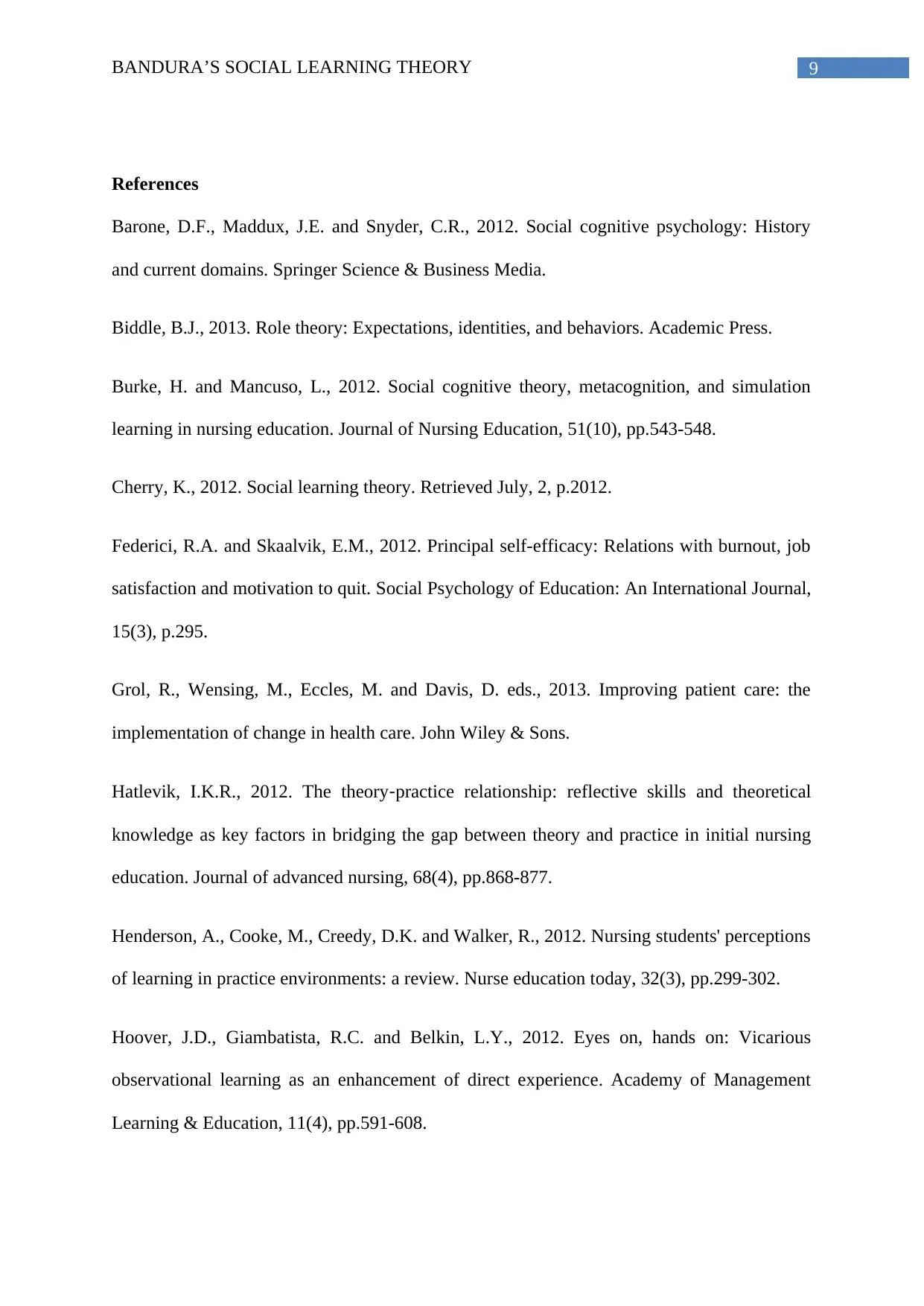
9BANDURA’S SOCIAL LEARNING THEORY
References
Barone, D.F., Maddux, J.E. and Snyder, C.R., 2012. Social cognitive psychology: History
and current domains. Springer Science & Business Media.
Biddle, B.J., 2013. Role theory: Expectations, identities, and behaviors. Academic Press.
Burke, H. and Mancuso, L., 2012. Social cognitive theory, metacognition, and simulation
learning in nursing education. Journal of Nursing Education, 51(10), pp.543-548.
Cherry, K., 2012. Social learning theory. Retrieved July, 2, p.2012.
Federici, R.A. and Skaalvik, E.M., 2012. Principal self-efficacy: Relations with burnout, job
satisfaction and motivation to quit. Social Psychology of Education: An International Journal,
15(3), p.295.
Grol, R., Wensing, M., Eccles, M. and Davis, D. eds., 2013. Improving patient care: the
implementation of change in health care. John Wiley & Sons.
Hatlevik, I.K.R., 2012. The theory‐practice relationship: reflective skills and theoretical
knowledge as key factors in bridging the gap between theory and practice in initial nursing
education. Journal of advanced nursing, 68(4), pp.868-877.
Henderson, A., Cooke, M., Creedy, D.K. and Walker, R., 2012. Nursing students' perceptions
of learning in practice environments: a review. Nurse education today, 32(3), pp.299-302.
Hoover, J.D., Giambatista, R.C. and Belkin, L.Y., 2012. Eyes on, hands on: Vicarious
observational learning as an enhancement of direct experience. Academy of Management
Learning & Education, 11(4), pp.591-608.
References
Barone, D.F., Maddux, J.E. and Snyder, C.R., 2012. Social cognitive psychology: History
and current domains. Springer Science & Business Media.
Biddle, B.J., 2013. Role theory: Expectations, identities, and behaviors. Academic Press.
Burke, H. and Mancuso, L., 2012. Social cognitive theory, metacognition, and simulation
learning in nursing education. Journal of Nursing Education, 51(10), pp.543-548.
Cherry, K., 2012. Social learning theory. Retrieved July, 2, p.2012.
Federici, R.A. and Skaalvik, E.M., 2012. Principal self-efficacy: Relations with burnout, job
satisfaction and motivation to quit. Social Psychology of Education: An International Journal,
15(3), p.295.
Grol, R., Wensing, M., Eccles, M. and Davis, D. eds., 2013. Improving patient care: the
implementation of change in health care. John Wiley & Sons.
Hatlevik, I.K.R., 2012. The theory‐practice relationship: reflective skills and theoretical
knowledge as key factors in bridging the gap between theory and practice in initial nursing
education. Journal of advanced nursing, 68(4), pp.868-877.
Henderson, A., Cooke, M., Creedy, D.K. and Walker, R., 2012. Nursing students' perceptions
of learning in practice environments: a review. Nurse education today, 32(3), pp.299-302.
Hoover, J.D., Giambatista, R.C. and Belkin, L.Y., 2012. Eyes on, hands on: Vicarious
observational learning as an enhancement of direct experience. Academy of Management
Learning & Education, 11(4), pp.591-608.
Paraphrase This Document
Need a fresh take? Get an instant paraphrase of this document with our AI Paraphraser
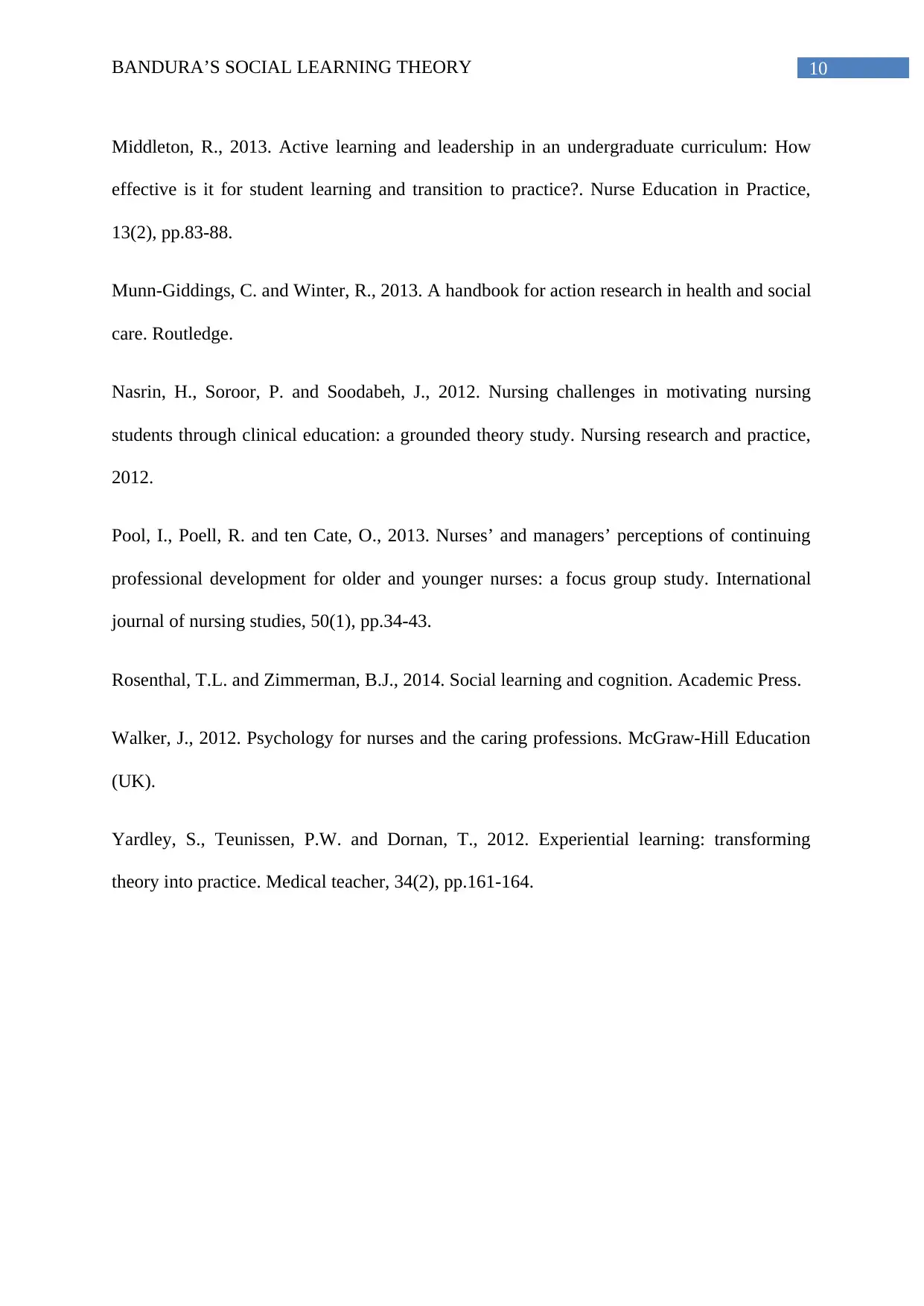
10BANDURA’S SOCIAL LEARNING THEORY
Middleton, R., 2013. Active learning and leadership in an undergraduate curriculum: How
effective is it for student learning and transition to practice?. Nurse Education in Practice,
13(2), pp.83-88.
Munn-Giddings, C. and Winter, R., 2013. A handbook for action research in health and social
care. Routledge.
Nasrin, H., Soroor, P. and Soodabeh, J., 2012. Nursing challenges in motivating nursing
students through clinical education: a grounded theory study. Nursing research and practice,
2012.
Pool, I., Poell, R. and ten Cate, O., 2013. Nurses’ and managers’ perceptions of continuing
professional development for older and younger nurses: a focus group study. International
journal of nursing studies, 50(1), pp.34-43.
Rosenthal, T.L. and Zimmerman, B.J., 2014. Social learning and cognition. Academic Press.
Walker, J., 2012. Psychology for nurses and the caring professions. McGraw-Hill Education
(UK).
Yardley, S., Teunissen, P.W. and Dornan, T., 2012. Experiential learning: transforming
theory into practice. Medical teacher, 34(2), pp.161-164.
Middleton, R., 2013. Active learning and leadership in an undergraduate curriculum: How
effective is it for student learning and transition to practice?. Nurse Education in Practice,
13(2), pp.83-88.
Munn-Giddings, C. and Winter, R., 2013. A handbook for action research in health and social
care. Routledge.
Nasrin, H., Soroor, P. and Soodabeh, J., 2012. Nursing challenges in motivating nursing
students through clinical education: a grounded theory study. Nursing research and practice,
2012.
Pool, I., Poell, R. and ten Cate, O., 2013. Nurses’ and managers’ perceptions of continuing
professional development for older and younger nurses: a focus group study. International
journal of nursing studies, 50(1), pp.34-43.
Rosenthal, T.L. and Zimmerman, B.J., 2014. Social learning and cognition. Academic Press.
Walker, J., 2012. Psychology for nurses and the caring professions. McGraw-Hill Education
(UK).
Yardley, S., Teunissen, P.W. and Dornan, T., 2012. Experiential learning: transforming
theory into practice. Medical teacher, 34(2), pp.161-164.
1 out of 11
Related Documents
Your All-in-One AI-Powered Toolkit for Academic Success.
+13062052269
info@desklib.com
Available 24*7 on WhatsApp / Email
![[object Object]](/_next/static/media/star-bottom.7253800d.svg)
Unlock your academic potential
Copyright © 2020–2025 A2Z Services. All Rights Reserved. Developed and managed by ZUCOL.





